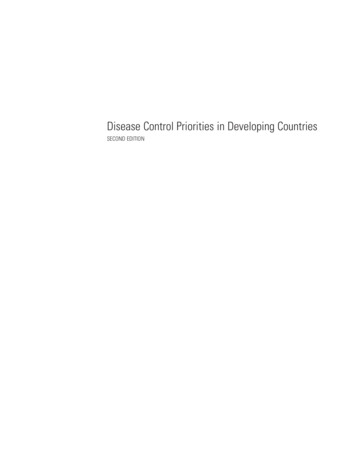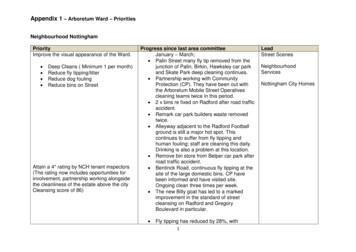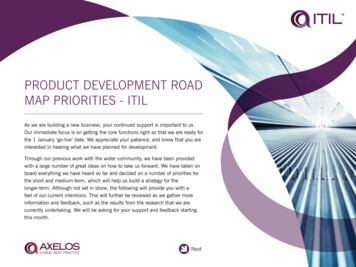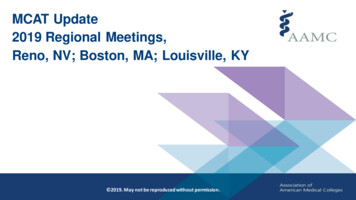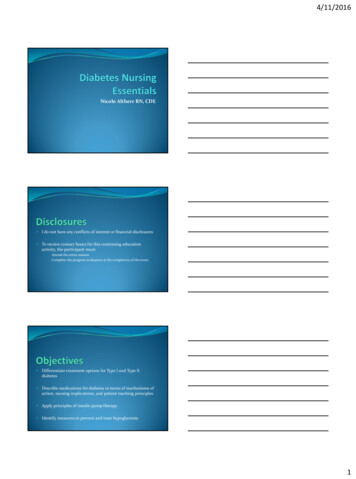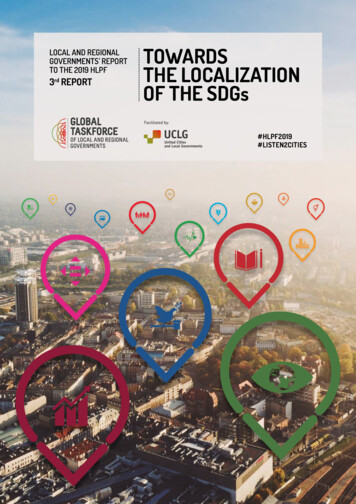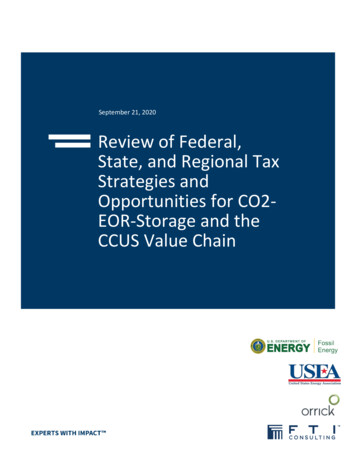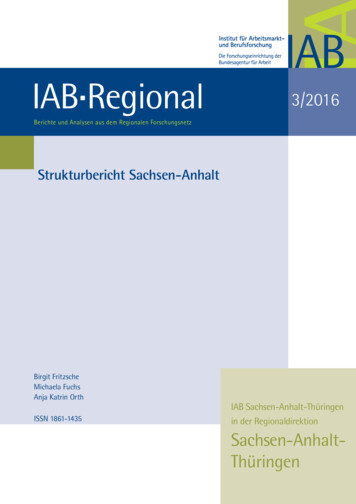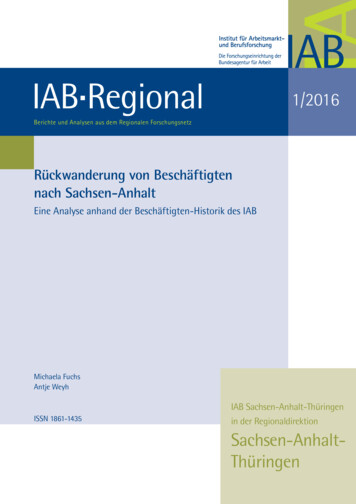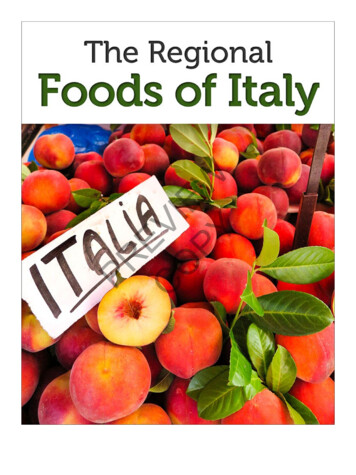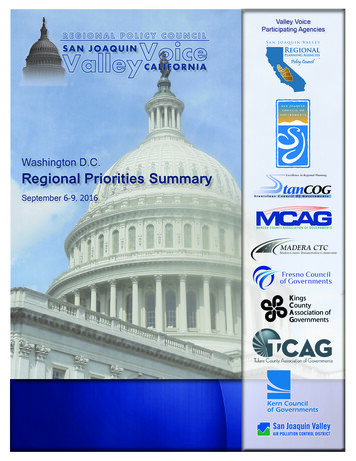
Transcription
Valley VoiceParticipating AgenciesSAN JOAQUINCALIFORNIAWashington D.C.Regional Priorities SummarySeptember 6-9, 2016
2016 Valley Voice Washington D.C.Priorities SummaryTable of Contents2016 Washington DC Valley Voice Delegates.1SJV Federal Transportation Grant Applications.2Goods Movement.3Reduction in Emissions Sources Under Federal Control.5Clean Air Act Modernization.6Regional Transportation Plan Cycles.7Farm-To-Market Routes.8MPO Role, Flexibility and Funding.9Water Quality, Supply and Reliability.10San Joaquin Valley of California Regional andTransportation Infrastructure Profile.11Valley Voice Delegation Contact Information.13SAN J O AQ U I NCALI F O R NI A
2016 Washington D.C. Valley Voice DelegatesSupervisor Chuck Winn, San Joaquin County, District 4Supervisor Bill O’Brien, Stanislaus County, District 1Supervisor Vito Chiesa, Stanislaus County, District 2Supervisor Daron McDaniel, Merced County, District 3Supervisor David Rogers, Madera County, District 2Supervisor Allen Ishida, Tulare County, District 1Mayor Mike Villalta, City of Los BanosMayor Robert Poythress, City of MaderaMayor Amarpreet Dhaliwal, City of San Joaquin -- Regional Policy Council ChairMayor Justin Mendes, City of HanfordMayor Rudy Mendoza, City of WoodlakeMayor Cheryl Wegman, City of WascoMayor Pro Tem Gary Yep, City of KermanCouncilmember Elbert Holman, City of StocktonCouncilmember Bill Zoslocki, City of ModestoRosa De Leon Park, Executive Director, Stanislaus Council of GovernmentsMarjie Kirn, Executive Director, Merced County Association of GovernmentsPatricia Taylor, Executive Director, Madera County Transportation CommissionTony Boren, Executive Director Fresno Council of GovernmentsTerri King, Executive Director, Kings County Association of GovernmentsTed Smalley, Executive Director, Tulare County Association of GovernmentsAhron Hakimi, Executive Director, Kern Council of GovernmentsSteve Dial, Deputy Executive Director, Chief Financial Officer, San Joaquin Council of GovernmentsBen Kimball, Deputy Executive Director, Tulare County Association of GovernmentsTom Jordan, Senior Policy Advisor, San Joaquin Valley Air Pollution Control DistrictThomas Reeves, Public Affairs Representative, Pacific Gas and Electric CompanyRobert Phipps, Administrative Services Director, Kern Council of GovernmentsSandra Ebersole, Grants Analyst, Madera County Transportation CommissionMichael Sigala, San Joaquin Valley Regional Policy Council Coordinator1.
San Joaquin Valley FederalTransportation Grant ApplicationsRequest Summary:1. The Federal Highway and Federal Transitadministrations should consider a community’s “economically disadvantaged” statusas a major criterion for grant funding. Thedefinition of “economically disadvantaged”should be determined by factors similar tothose used in the California CommunitiesEnvironmental Health Screening Tool (CalEnviroScreen), including:Despite a collective population of more than 4 millionpeople today, which is expected to grow to more than 5.4million, or 26 percent of state population by 2050, jurisdictions in the San Joaquin Valley routinely have theirprojects overlooked during the competitive grant processfor the TIGER and FASTLANE programs, both by Caltransand the Federal Highway Administration.Situated between the Bay Area and Southern California– neither entirely urban nor rural – and with economicand environmental conditions similar to the Appalachianregion, the SJV should be provided greater opportunitiesto compete for available federal grant funding with largermetropolitan areas.a. Areas disproportionately affected by environmental pollution and other hazardsthat can lead to negative public healtheffects, exposure, or environmental degradation, andb. Areas with concentrations of people thatare of low income, high unemployment,low levels of home ownership, high rentburden, sensitive populations, or lowlevels of educational attainment.2. Congress should consider amending theFAST Act to provide for “mid-range” applicants under the FASTLANE and TIGERprograms specifically for those municipalitiesor counties between 200,000 and 1 million inpopulation.CONTACT:Ted SmalleyExecutive DirectorTulare County Association of Governments210 N. Church Street, Suite BVisalia, CA 93291Email: tsmalley@tularecog.orgPhone: 559-623-0450Owing to its status as the premiere agricultural provider inthe nation, the SJV routinely faces 15 percent unemployment with 19 percent of the population classified as livingunder the federal poverty line. At the same time, however,the Valley’s housing affordability continues to attract newresidents and road miles, which now number 31,400 or 18percent of California’s total.Logistics comprises one Valley economy’s fastest-growingsegments and is quickly becoming the lifeblood of farmers, manufacturers, oil providers and others who dependon infrastructure to move their goods to market. For theSJV to accommodate its anticipated growth, it will needto compete effectively for all available federal funding ona level playing field that considers its unique location andcircumstances.SAN JOAQUINCALIFORNIA2.
Goods MovementRequest Summary:The San Joaquin Valley is California’s fastest growingregion and the nation’s number one agricultural producer,generating more than 35 billion in the gross value of agricultural commodities such as milk, nuts, lettuce, tomatoes, wine, grains and other products. The Valley playsa major role in processed foods and energy productsnationally and internationally. As a growing and diversifiedregion, the Valley depends on an efficient goods movement system for its long-term economic success and tosafely move Valley resources for transport throughout therest of the nation.1. Support FAST Act discretionary freightprogramming (FASTLANE) for regionallysignificant projects in the San JoaquinValley. These priority projects arehighlighted in attached letter from thecongressional delegation of the SanJoaquin Valley.2. Support FAST Act formula programmingthat includes a fair and equitable distribution and consultation process between theValley MPOs and state and federal apportionment agencies.The eight San Joaquin Valley Regional Planning Agencies continue to work in partnership with federal and stateagencies, and key private stakeholders to promote freightmovement, and the economy, for our region. The SanJoaquin Valley Interregional Goods Movement Plan, finalized in 2013, highlighted how freight movement is a vitalcomponent of the San Joaquin Valley’s diverse economythat significantly plays a major role in the distribution ofagricultural materials throughout California, the UnitedStates, and the world. The Plan is being updated in 201617 with additional analysis for priority rural corridors andfirst-and-last mile connectors. It is anticipated that manyof the priority projects identified through our planningefforts will also be eligible for federal Fixing America’sSurface Transportation (FAST) Act freight funding.3. Support policy and funding for priorityprojects identified in the ongoing SanJoaquin Valley Interregional GoodsMovement planning processes.CONTACT:Ted SmalleyExecutive DirectorTulare County Association of Governments210 N. Church Street, Suite BVisalia, CA 93291Email: tsmalley@tularecog.orgPhone: 559-623-0450 25 percent of all food in the United States comesfrom the San Joaquin Valley. Over 500 million tons of commodities are transported in the San Joaquin Valley annually; projected toincrease to 800 million tons by 2040. Trucks are the dominant mode and account for 90percent of all freight movement. State Route (SR) 99 and Interstate 5 (I-5) serve asthe backbone to our goods movement system andhave higher than average truck percentage volumes. SR 99 and I-5 are on the National PrimaryFreight Network. Lack of capacity for both State Route 99 and Interstate 5 results in congestion and poor air quality forthe region. Over 44 percent of all employment in the San Joaquin Valley is associated with goods movement-de-SAN JOAQUINCALIFORNIA3.
pendent industries. This percentage is higher thangoods movement related employment in all otherregions of California.SR 99 and I-5 are critical arteries for goods movementin the State of California and the San Joaquin Valley.Deferred maintenance and the lack of capacity are majorissues for SR 99 and I-5. Capacity upgrades for SR 99 toa minimum of six lanes throughout the Valley total approximately 110 miles are estimated to cost 1.6 billion.Additionally, east-west connectors and first-and-last-mileconnectors play a critical role in supporting the Valley’sgoods movement network.The San Joaquin Valley is fully prepared to compete fornew federal freight-related funding through the FASTAct, which includes a new Nationally Significant Freightand Highway Projects Program, at 4.5 billion over fiveyears, and a freight formula program, the National Highway Freight Program, at 6.3 billion over five years.SANJOAQUINCALAVERASThe San Joaquin Valley goods movement interregionalinfrastructuresystem includes:PriorityGoodsMovementTUOLUMNE MONOMARIPOSASTANISLAUS MADERAMERCEDFRESNO Project31,420roadwayListmiles for theTwo major Class1 railroads(BNSF Railway &SanJoaquinUnion Pacific)ValleyShort line and regional railroadsThe Port of StocktonSeven air cargo airportsSeveral existing and planned multimodaltransfer facilitiesÿ}599SAN ERNARDINOPriority Goods Movement ProjectsSan Joaquin County, SR 120 - Widen freeway from I-5 to SR 99. Constructconnector ramps and bridges, total cost 116MStanislaus County, SR 99/SR 132 - Construct SR 99/SR 132 freeway to freewayinterchange and SR 132/Carpenter Road interchange, total cost 260MLOS ANGELESMerced County, SR 99 - Widen freeway to 6 lanes from Stanislaus/MercedCounty line to Hammatt Ave, total cost 29.1MMadera County, SR 99 - Widen freeway to 6 lanes from Ave 12 to Ave 17, totalcost 62.5MFresno County, SR 180 - Extend expressway to 4 lanes east of Frankwood Avetowards Kings Canyon/Sequoia National Parks, total cost 100.2MKings County, SR 41 - Widen freeway to 4 lanes from Kings/Fresno County lineto Elkhorn Ave, total cost 40.6MORANGERIVERSIDETulare County, SR 99 - Widen freeway to 6 lanes from Caldwell to Prosperity, totalcost 80MKern County, SR 58/SR 99 - Construct connector ramps and bridges, total cost 150M4.SAN DIEGO8/24/2016Seth Scott, Fresno COGM:\Seth\Projects\Brenda\2016-08-23 Goods Movement\Goods Movement.mxd
Reduction in Emissions Sources UnderFederal ControlRequest Summary:1. Support the San Joaquin Valley Air Pollution Control District petition requestingthat EPA adopt new national standards foron-road heavy-duty trucks and locomotivesunder federal jurisdiction.In addition to the many attainment plans that have alreadybeen developed and implemented, the San JoaquinValley is mandated under the Clean Air Act to developand adopt a number of new ozone and particulatematter plans in the coming years. The degree of difficultyfaced by the Valley in meeting the new federal ambient airquality standards are unmatched by any other region inthe nation. Attainment of the latest standards will requiretransformative changes and development of innovativecontrol strategies to significantly reduce emissions frommobile sources, which now make up over 85% of theValley’s NOx emissions.2. Establish a National Clean Air InvestmentFund to accelerate the deployment oflow-emission vehicles in a timeframe thatwill allow the Valley to meet National Ambient Air Quality Standards, protect publichealth, and avoid federal sanctions that willhave a devastating impact upon the region.Over the next few years, the Valley must adopt a numberof attainment plans to address the following standards: 2006 PM2.5 Standard (35 μg/m324-hr and 15 μg/m3 annual) 2012 PM2.5 Standard (12 μg/m3annual) 2008 Ozone standard (75 ppb 8-hr) 2015 Ozone Standard (70 ppb 8-hr)San Joaquin Valley NOx Emissions andFederal Air Quality Standards325300Stationary and Area Sources275250Other Off-Road, including TrainsOff-Road EquipmentTons per Day225200Farm EquipmentStationary andArea Sources175150Other Off-Road, including TrainsPassenger CarsOff-Road Equipment12575Attainment of2008 8-hrozonestandardFarm Equipment100Heavy Duty Trucks50MobileSourcesPassenger CarsAttainmentof NewPM2.5 and8-hr ozonestandardsHeavy Duty Trucks2502013Attainment of1997 8-hrozonestandard2019CONTACT:Tom Jordan, Senior Policy AdvisorSan Joaquin Valley Air Pollution Control District1990 E. Gettysburg Avenue, Fresno, CA 93726Email: tom.jordan@valleyair.orgPhone: 559-230-6000Despite achieving significant emissionsreductions through decades of implementing the most stringent stationaryand mobile regulatory control programin the nation, NOx emissions (primaryprecursor for both ozone and PM2.5)in the San Joaquin Valley must bereduced by an additional 90% in orderto attain the latest federal ozone andPM2.5 standards that now encroachon natural background levels. This airquality challenge is unmatched by anyother region in the nation.The District has jurisdiction over stationary and areasources, which make up less than 15% of the totalNOx emissions inventory (Figure 1). The remainderof emissions are associated with mobile sources, themajority of which fall under federal control. The Valleywill leave no stone unturned in seeking additionalreductions from stationary sources of emissions.SAN JOAQUINCALIFORNI A5.
Clean Air Act ModernizationProblem 1: Every five years the Clean Air Act requires thatEPA review and update air quality standards. The transitionbetween standards is chaotic and leads to a number of overlapping plans with different milestones and attainment dates.In the Valley, there are six active air plans (one for a revokedstandard). Over the next two years, four new plans must bedeveloped. Solution 1: When a new standard is published,the old standard for that pollutant should be subsumed.States should be allowed to develop a single attainment planthat harmonizes increments of progress and other milestoneswithout allowing for any rollback or backsliding.Request Summary:Support HR 4775-Ozone Standards Implementation Act of 2016 and S 2882-Ozone StandardsImplementation Act of 2016 that contain elementsof the Valley’s Clean Air Act Modernizationproposal.The Clean Air Act was last amended in 1990. Overthe last 25 years, local, state, and federal agenciesand affected stakeholders have learned importantlessons from implementing the law and it is clearnow that a number of well-intentioned provisions inthe Act are leading to unintended consequences.This experience can inform efforts to enhance theClean Air Act with much needed modernization.Problem 2: Mobile and stationary sources throughout thenation have now been subject to multiple generations oftechnology forcing regulations that have achieved significantair quality benefits. Meeting the new standards that approachbackground concentrations call for transformative measuresthat require time to develop and implement. These transformative measures require new technologies that in manycases are not yet commercially available or even conceived.The formula-based deadlines and milestones that wereprescribed in the Act 25 years ago now lead to mandatesthat are impossible to meet. Solution 2: In establishingdeadlines and milestones, the Act should be amended torequire control measures that lead to the most expeditiousattainment of health based standards while taking intoaccount technological and economic feasibility.The Clean Air Act needs to be strategically amendedto address the following five issues. We urge actionon this matter as we believe that inaction will setmany regions up for failure and economic devastation as the new federal standards encroach onbackground pollution concentrations.Problem 3: The Act as it relates to the demonstration ofReasonable Further Progress or Rate of Progress treats allprecursors the same, regardless of their potency in harmingpublic health or achieving attainment. Solution 3: The Actshould be amended to allow states to focus efforts onmeeting new standards in the most expeditious fashionthrough deployment of scarce resources in a manner thatprovides the utmost benefit to public health.CONTACT:Tom Jordan, Senior Policy AdvisorSan Joaquin Valley Air Pollution Control District1990 E. Gettysburg Avenue, Fresno, CA 93726Email: tom.jordan@valleyair.orgPhone: 559-230-6000Problem 4: Requiring contingency measures in extremenonattainment areas is irrational and unnecessary. Theseareas, by definition, have already implemented all availableand foreseeable measures and still need a “black box” offuture measures to define and employ. Solution 4: Werecommend that the Act be amended to eliminate therequirement for contingency measures in areas classifiedas “extreme” non-attainment by EPA.SAN JOAQUINCALIFORNI A6.Problem 5: The Act requirements for severe and extremeozone nonattainment areas to address vehicle-related emissions growth must be clarified. Solution 5: The Act shouldbe amended to allow states to take credit for all transportationcontrol measures and strategies and not punish areas thathave implemented transportation control measures andstrategies that have achieved early reductions in emissions.
Regional Transportation PlansChange Adoption From 4- to 8-Year CyclesRequest Summary:Allow Regional Transportation Plans to beupdated every 8 years instead of every 4years.The Regional Transportation Plan (RTP) is a 25-yearblueprint for transportation projects and funding in a region.They are prepared by Metropolitan Planning Organizations(MPOs) in order to develop our regional goal and prioritylist of projects and to qualify these projects for Federal andState Programming and Funding. They involve years ofmodeling, planning, public outreach extensive environmental review and are required to be updated every four (4)years at considerable cost.By the time the RTP is completed, there is little or no timeto implement it or to access performance before it is timeto start developing the next one. The RTP would be moreuseful if it was not required to be updated so often, whichwould also save significant time and expense, make theprocess of planning and programming much more efficient.CONTACT:Ted SmalleyExecutive DirectorTulare County Association of Governments210 N. Church Street, Suite BVisalia, CA 93291Email: tsmalley@tularecog.orgPhone: 559-623-0450SAN JOAQUINCALIFORNI A7.
Farm to Market RoutesLong-Term Funding For Important Agricultural RoutesRequest Summary:Provide Special Funding for Rural Roads thatare used by dairies for daily farm to market shipping through a set aside in the next Transportation or Farm Bill.The dairy industry is California’s leading commodity incash receipts, generating a record 9.4 billion for milkproduction in 2014, up 23% from 2013 and 22% abovethe record year of 2011. The dairy industry represents asignificant industry in the economy of the San JoaquinValley (SJV) Counties. According to a survey of therecent county crop reports, milk is ranked in the top 3commodities for 7 of the 8 SJV counties with an estimatedvalue at 7.7 billion or 82% of California’s total market.There are at least 775 dairies in the Valley transportingmillions of pounds of milk and milk products per day,which travel on local county and city roads in order toconnect to the State Highway system.Unlike other agricultural goods with a short, definedharvest season
SAN DIEGO LOS ANGELES SAN JOAQUIN STANISLAUS MERCED MADERA FRESNO TULARE KINGS KERN 5 8/24/2016 Seth Scott, Fresno COG M:\Seth\Projects\Brenda\2016-08-23 Goods Movement\Goods_Movement.mxd Priority Goods Movement Project List for the San Joaquin Valley Priority Goods Movement Projects San

